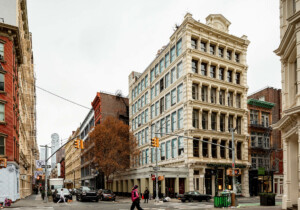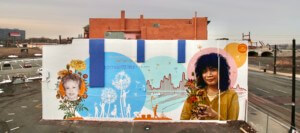Flows Two Ways by Stephen Glassman Studio is one of the most innovative new public art wall projects in New York. The walls of the city have a long and complicated history as a site for public art that includes 19th century classical Beaux Arts reliefs, WPA scenes on (and in) libraries, hospitals and public housing, and the graffiti that covers buildings all over the city. Furthermore, in the 1970s the loosely organized group City Walls created opportunities for artists to use blank, lot line facades all over downtown Manhattan, particularly in Soho and Noho. Only two City Walls murals remain in 2016 but there were many large works by artists such as Allan D’Arcangelo, Mel Pekarsky, Tania Lewin, Robert Wiegand, Todd Williams, and Forrest Myers. This was a moment when bare, unpainted walls were plentiful downtown and City Walls helped created a template and process for covering them with large graphic images. These artists’ projects grabbed the public’s attention and helped define the art of Soho in the 1970s but, sadly, their work only became a template for commercial advertising signs.
Except for the late, lamented 5 Pointz graffiti wall in Queens, there haven’t been many wall projects of interest in New York since the 1970s—or until now, with Flows Two Ways. The Stephen Glassman project is sited on a new passageway few New Yorkers even know exists. The work is not a painted mural but a raised sculpture that measures sixty-by-sixty feet. It sits on a narrow passageway between the BIG-Bjarke Ingels Group-designed Via 57 West building and the Helena by FxFowle. It was commissioned by the Durst Organization, the owners of both developments. The piece was created through a truly 21st-century process of prefabricated construction.
The mural is composed of colored aluminum, stainless steel, and rolled metal tubing. Furthermore, the layered eight-story, 32,000-pound jig-saw puzzle is composed of a stainless-steel mounting matrix embedded into the existing Helena wall, 35 interlocking aluminum panels, nearly 400 sixty-foot pipe clusters rolled and flowing in three axes, and faceted metal “boulders.” A sophisticated sliding plate system—which largely floats the 16-ton piece off the building—accommodates thermal expansion and forces generated by wind, rain, snow, and ice loads. It is effectively a panelized façade. To develop this technologically complex sculpture, Glassman used a team of engineers from Arup, architects, and designers to craft its layered construction and anchoring system.
The artist’s intent for the work is to evoke “an enduring regard for earth and nature and a love of New York.” It cascades down and up the facade; Glassman says it replicates “the dualities of flowing and falling.” By playing with the sun’s changing angles, the artwork mimics the Hudson River’s glow at sunset.
In particular, the artist hopes the work will direct the eye of the viewer upward to the sky rather than the confined, dark space of the narrow alley. The sculpture’s palette, derived through color studies of the historic Hudson River school of painting, imbues the passageway with an organic counterpoint to the surrounding steel and glass built environment. In fact, the majority of units facing onto the artwork are subsidized middle-income apartments that, without the colorful work, would be looking onto a narrow passageway’s drab sheer concrete wall. The sculpture points to a new type of composite and prefabricated construction that can transform a blank vertical wall and otherwise dead space into a colorfully vibrant urban space.










